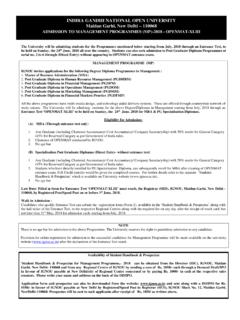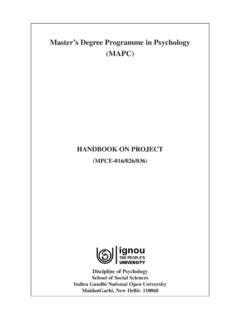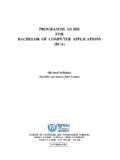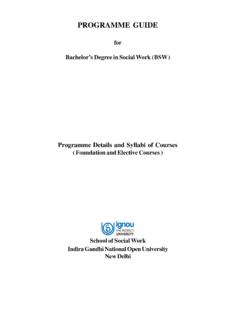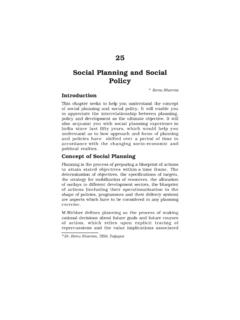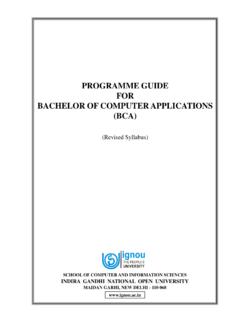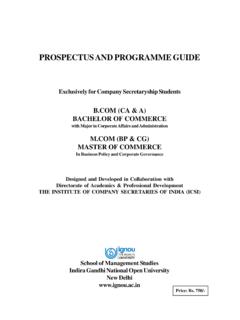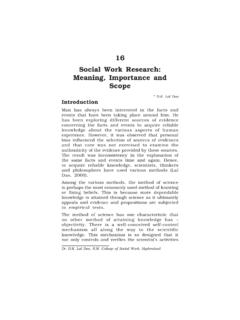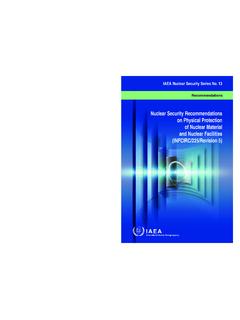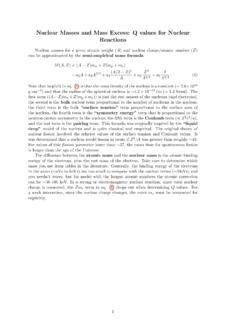Transcription of UNIT 3 NUCLEAR POWER PLANT Nuclear Power Plant
1 NUCLEAR POWER PLANT UNIT 3 NUCLEAR POWER PLANT . Structure Introduction Objectives Atomic Structure of Matter Atomic Nomenclature NUCLEAR Binding Energy Mass Defect NUCLEAR Fission Controlled NUCLEAR Fission Spontaneous NUCLEAR Fission NUCLEAR Fusion NUCLEAR Reaction NUCLEAR Chain Reactions Fission Chain Reaction Types of NUCLEAR Materials Fissile Material Fertile Material NUCLEAR POWER Reactors Boiling Water Reactor (BWR). CANDU Type Reactor Comparison of NUCLEAR POWER Station with a Steam POWER Station Health Hazards Safety Precaution Summary Key Words Answers to SAQs INTRODUCTION. Due to the high demand of electric POWER in all the fields, like industries, commercial, institutional and housings, etc. the shortage of electric POWER is becoming a big problem in day-to-day. It may be due to the technological development or need of the changing life styles of the human. In most of the summers all the cities and rural areas also facing the problem of POWER cuts, this is due to over burden of the POWER or usage of POWER is increasing day-by-day.
2 Electric POWER has become an important and essential resources, it is used for all the purposes. Without electric POWER , a single day cannot move further. Keeping in mind the above problem, the R & D of government departments are establishing different modes of POWER generation plants. NUCLEAR POWER PLANT is one of the mode of the POWER generation. In this unit, we study about the NUCLEAR POWER PLANT . Objectives After studying this unit, you should be able to understand the NUCLEAR reactions, know the NUCLEAR materials, 85. POWER PLANT Engineering describe all types of NUCLEAR reactors, and explain about the NUCLEAR POWER station. ATOMIC STRUCTURE OF MATTER. Atomic Structure All atoms are composed of a central nucleus surrounded by a number of orbiting electrons like planets orbiting the sun. Figure : Atomic Structure A problem is that orbiting electrons would be accelerating and should radiate energy causing them to spiral into the nucleus.
3 Atomic Nomenclature An atomic nucleus is the small heavy central part of an atom consisting of A nucleons : Z protons and N neutrons. A is referred to as the mass number and Z the atomic number. NUCLEAR size is measured in fermis (also called femtometres), where 1 fm = 10-15 m. The basic properties of atomic constituents are as follows : Charge Mass (u) Spin (h/2 )* Magnetic Moment (J T 1)**. Proton e 1/2 10 26. Neutron e 1/2 10 27. Electron e 1/2 10 24. * h = 10 34 Js, is Planck s constant ** The unit T is the tesla the SI unit of magnetic field. Charge Protons have a positive charge equal and opposite to that of the electron. Neutrons are uncharged. Thus a neutral atom (A, Z) contains Z electrons and can be written A. symbolically as Z XN . Mass NUCLEAR and atomic masses are expressed in atomic mass units (u) based on the 12. definition that the mass of a neutral atom of C is exactly u.
4 (1 u = 10 27 kg). 86. Spin NUCLEAR POWER PLANT Each of the constituents has a spin 1/2 in units of h/2 and is an example of the class of particles of half-integer spin known as fermions. Fermions obey the Exclusion Principle, first enunciated by Wolfgang Pauli in 1925, which determines the way electrons can occupy atomic energy states. The same rule applies to nucleons in nuclei. Magnetic Moment Associated with the spin is a magnetic dipole moment. Compared with the magnetic moment of an electron, NUCLEAR moments are very small. However, they play an important role in the theory of NUCLEAR structure. It may be surprising that the uncharged neutron has a magnetic moment. This reflects the fact that it has an underlying quark sub-structure, consisting of charged components. An important application of NUCLEAR moments, based on their behaviour in electromagnetic fields, is the technique of magnetic resonance imaging [MRI] or NUCLEAR magnetic resonance.
5 An atom can be ionized by losing one or more electrons and forming a positive ion ( Fe+, Cu+). gaining additional electrons and forming a negative ion ( O , O ). Elements, Isotopes, Isotones and Isobars The name of an element uniquely identifies the atomic number Z. Element Atomic Number Z. Hydrogen 1. Helium 2. Lithium 3. Beryllium 4. Boron 5. Carbon 6.. Uranium 92. Neptunium 93. Plutonium 94. Isotopes of an Element Atoms whose nuclei have the same Z but different N. The electron structure and, the chemical properties of isotopes are similar. For example, Carbon has three naturally occurring isotopes 12 13 14. 6 C6 , 6 C7 , 6 C8. Isotones Nuclides with the same N and different Z. Isobars Nuclides with the same mass number A. It is usual to omit the N and Z subscripts from the symbolic representation and include only the mass number as superscript: Forces Acting in Atoms and Nuclei The electromagnetic force acts as an attractive force between electrons and the nucleus and as a repulsive force between protons inside the nucleus.
6 Within the 87. POWER PLANT Engineering nucleus, a strong, short-range force holds nucleons together in close proximity to each other. There is also a very much weaker NUCLEAR force, which gives rise to radioactivity. The gravitational force acts between objects with mass, but is only perceived when masses are large. It is totally negligible in its effect on the structure of atoms and nuclei. ATOMIC NOMENCLATURE. All atoms are made up of three subatomic particles: the proton, neutron and electron. Each determines part of how we see an atom: The number of protons in an atom determines its atomic number. This is the atoms identity : all atoms with one proton are hydrogen atoms, all atoms with two protons are helium atoms and so on. The atomic number (Z) is the same as the number of the element in the periodic table. The atomic number is denoted with a leading subscript: 2He refers to a helium atom with two protons.
7 The sum of the number of protons and neutrons together determines the atomic mass. The atomic mass is denoted with a leading superscript : 42He refers to a helium atom with 2 protons (subscript = atomic number) and 4 total neutrons and protons. Thus, it has two neutrons. Changing the number of neutrons in an atom creates an isotope of that atom: the atom identity stays the same, but the atomic mass changes. A helium atom with only one neutron would have the symbol 32He : helium-3 is an isotope of helium with two protons and (2 protons + 1 neutron) = 3 atomic mass The electrons of an atom exist in a cloud around the nucleus. In a neutral atom there are as many electrons as there are protons. Adding or subtracting an electron creates an ion of that atom. This is denoted by placing a trailing superscript with the charge on the atomic symbol. For example, an atom of helium-3 that lost an electron would have a +1 charge and a symbol 32He+.
8 To summarise : Changing the No. of protons changes the element. Changing the No. of neutrons changes the isotope of that element. Changing the No. of electrons creates an ion of that element. NUCLEAR BINDING ENERGY. Nuclei are made up of protons and neutron, but the mass of a nucleus is always less than the sum of the individual masses of the protons and neutrons which constitute it. The difference is a measure of the NUCLEAR binding energy which holds the nucleus together. The enormity of the NUCLEAR binding energy can perhaps be better appreciated by comparing it to the binding energy of an electron in an atom. The comparison of the alpha particle binding energy with the binding energy of the electron in a hydrogen atom is shown below. The NUCLEAR binding energies are on the order of a million times greater than the electron binding energies of atoms. Figure : Comparison of Atomic and NUCLEAR Scales and Binding Energy 88.
9 NUCLEAR POWER PLANT Figure : NUCLEAR Binding Energy Curve The binding energy curve is obtained by dividing the total NUCLEAR binding energy by the number of nucleons. The fact that there is a peak in the binding energy curve in the region of stability near iron means that either the breakup of heavier nuclei (fission) or the combining of lighter nuclei (fusion) will yield nuclei which are more tightly bound (less mass per nucleon). The binding energies of nucleons are in the range of millions of electron volts compared to tens of eV for atomic electrons. Whereas an atomic transition might emit a photon in the range of a few electron volts, perhaps in the visible light region, NUCLEAR transitions can emit gamma-rays with quantum energies in the MeV range. MASS DEFECT. The distance between theoretical calculated mass and experimentally measured mass of nucleus is called mass defect.
10 It is denoted by m. It can be calculated as follows : Mass defect = (Theoretical calculated mass) (measured mass of nucleus). (sum of masses of protons and neutrons) (measured mass of nucleus). In NUCLEAR reactions, the energy that must be radiated or otherwise removed as binding energy may be in the form of electromagnetic waves, such as gamma radiation, or as heat. Again, however, no mass deficit can in theory appear until this radiation has been emitted and is no longer part of the system. The energy given off during either NUCLEAR fusion or NUCLEAR fission is the difference between the binding energies of the fuel and the fusion or fission products. In practice, this energy may also be calculated from the substantial mass differences between the fuel and products. When the nucleons are grouped together to form a nucleus, they lose a small amount of mass, there is mass defect.
